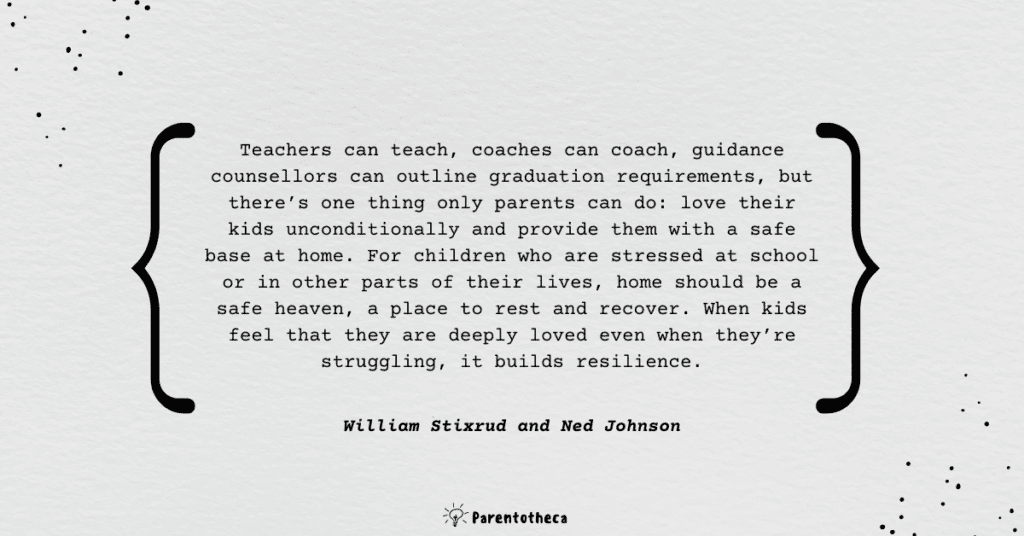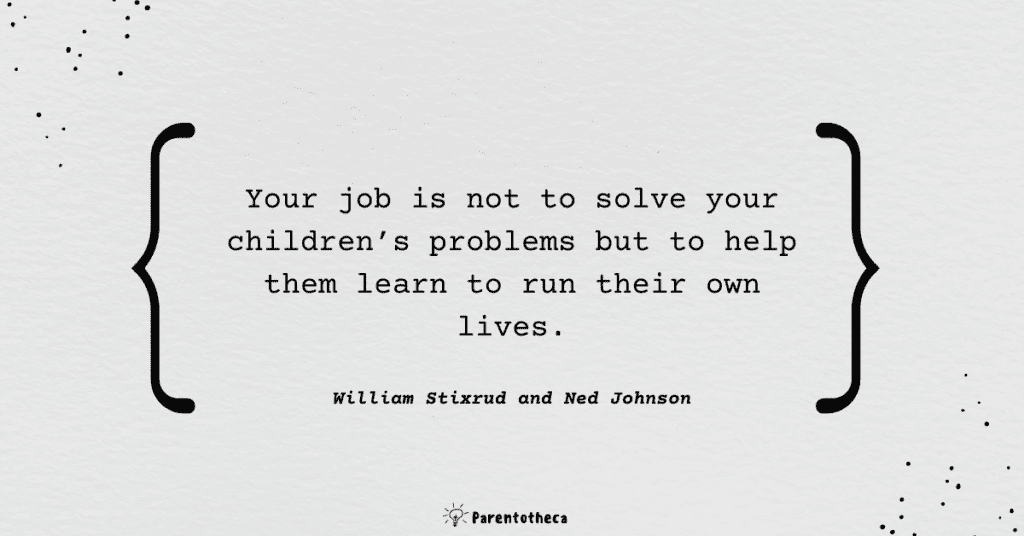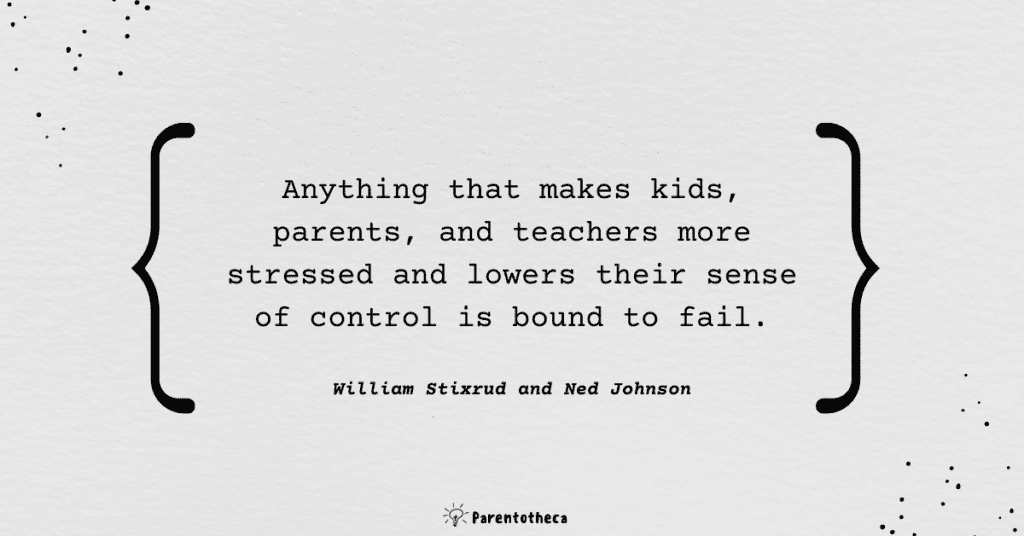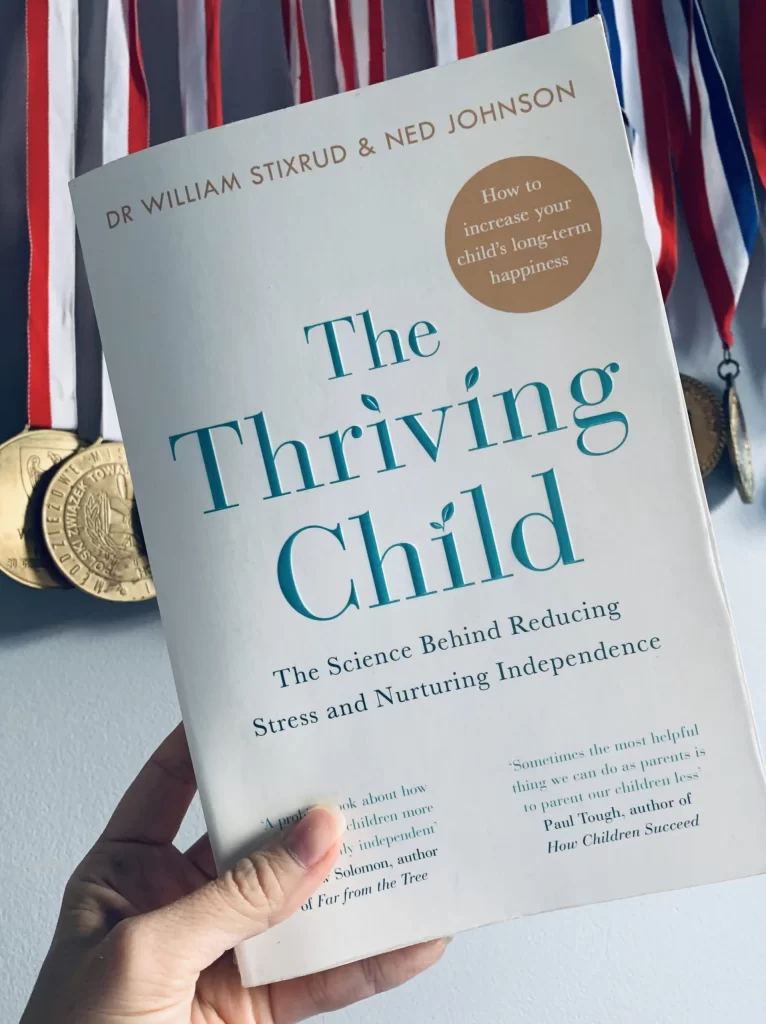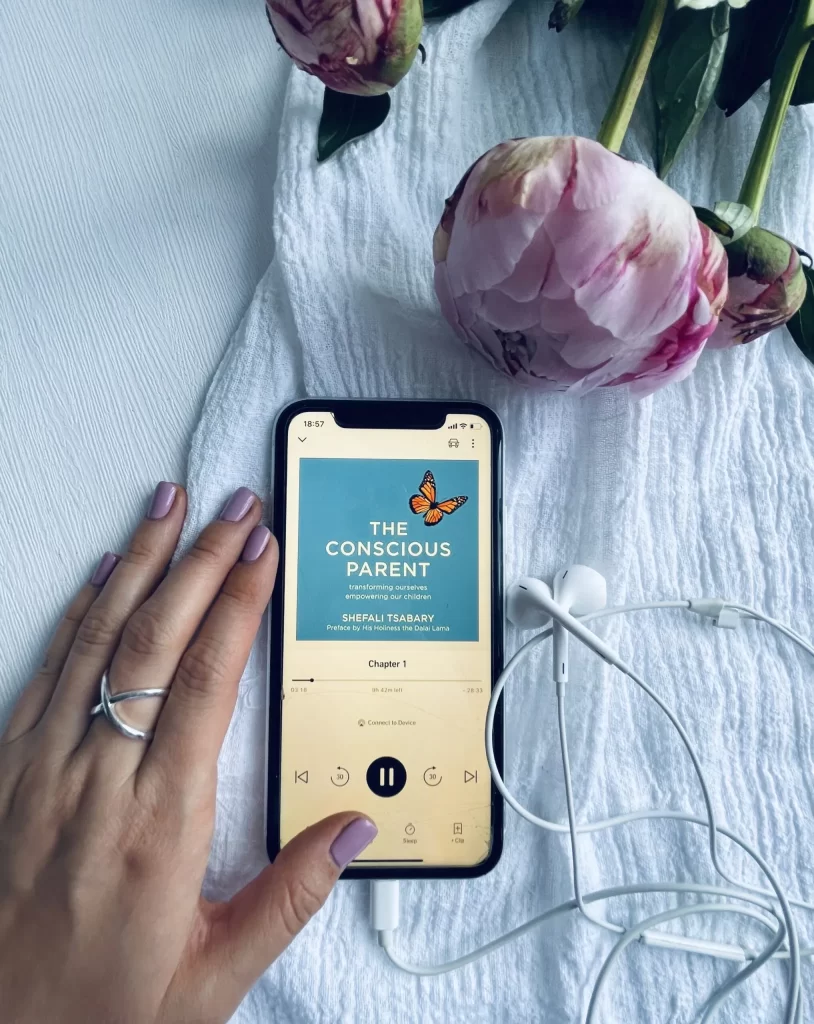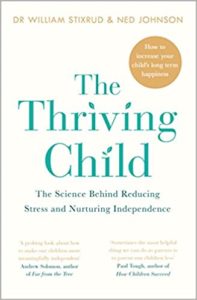 The Thriving Child
The Thriving Child
The science behind reducing stress and nurturing independence
William Stixrud and Ned Johnson
Penguin Life (14 Jun. 2018)
About The Authors
William R. Stixrud, PhD, is a clinical neuropsychologist and founder of The Stixrud Group. He is a member of the teaching faculty at Children’s National Medical Center and an assistant professor of psychiatry and paediatrics at the George Washington University School of Medicine.
Ned Johnson is an author, speaker, and the founder of an elite tutoring company, PrepMatters.
About The Book
“A major goal of this book is to help parents help their kids increase their stress tolerance – their ability to perform well in stressful situations – and to “throw off” stress rather than accumulate it. Stress tolerance is highly correlated to success in all aspects of life. We want to challenge our kids without overwhelming them, to stretch them without breaking them. We want them to experience some positive stress and some tolerable stress, but in the right ways, and with the right bolstering. We want to give their brains all the support and room they need to grow strong. The how of all of this comes back again and again and again to a sense of control. “
This book is a must-read for every parent who truly cares about their child. Drawing on research and their experience, Dr Stixrud and Ned Johnson help us understand how nurturing independent thinking, and collaborating with your child rather than micro-managing them, will lead to happier, smarter and stress-free children.
The book is literally packed with big ideas and practical strategies. In these notes, we’ll cover just a few of them, so we definitely recommend grabbing the book. For now, let’s jump straight in.
Key Insights
A Sense of Control is a Key to Thriving.
“Without a healthy sense of control, kids feel powerless and overwhelmed and will often become passive or resigned. When they are denied the ability to make meaningful choices, they are at high risk of becoming anxious, struggling to manage anger, becoming self-destructive, or self-medicating. Despite the many resources and opportunities their parents offer them, they will often fail to thrive. Without a sense of control, regardless of their background, inner turmoil will take its toll.”
A healthy sense of control is the key to thriving in life. If they grow up with the feeling that they can impact the world around them, they will certainly succeed. It’s that simple.
Dr Stixrud and Ned Johnson explain that a low sense of control is stressful for humans. In fact, it may be the most stressful thing in the universe. And when stress becomes chronic, it’s harmful to the brain, especially for young brains.
That’s why a sense of control is pretty much an antidote to stress – if we have confidence that we can impact a situation, it will be less stressful. And guess what? Over the last few decades, study after study has found that a high sense of control goes hand in hand with better physical health, less use of drugs and alcohol, greater longevity, lower stress, positive emotional well-being, greater internal motivation, improved academic performance, and enhanced career success. All good things we wish for our kids.
So here is a different perspective on parenting:
“We really can’t control our kids – and doing so shouldn’t be our goal. Our role is to teach them to think and act independently, so that they will have the judgement to succeed in school and, most important, in life. Rather than pushing them to do things they resist, we should seek to help them find things they love and develop their inner motivation. Our aim is to move away from a model that depends on parental pressure to one that nurtures a child’s own drive. That is what we mean by the thriving child.”
That’s very wise. That also resonates with Julie Lythcott-Haims’s ideas in How to raise an adult – overparenting is harmful.
Don’t enforce your way, but nurture your child’s own drive. Kids are competent from birth, and we need to help them develop the skills to figure out their own way that’s right for them.
Stress Immunisation
“Let us make one clear thing: we don’t think it’s possible to protect kids from all stressful experiences, nor would we want to. In fact, when kids are constantly shielded from circumstances that make them anxious, it tends to make their anxiety worse. We want them to learn how to deal successfully with stressful situations – to have high stress tolerance. That’s how they develop resilience. If a child feels like he’s in control in a stressful situation, then in later situations when he might actually not be in control, his brain will be equipped to handle that stress better. He is, in effect, immunised.”
Basically, there are three levels of stress: positive stress (it motivates both children and adults to grow, take risks and perform at a high level), tolerable stress (which occurs for a relatively brief period, but kids need to have support from adults and enough time to cope and recover) and toxic stress (frequent or prolonged activation of the stress system in the absence of support). So kids actually need positive stress as well as tolerable stress to build resilience. But for this “immunisation” to go smoothly, kids need a supportive adult around, they need time to recover, and they need to have a sense of control.
If kids are chronically stressed, their brains get flooded with stress hormones that dull higher brain functions and stunt their emotional responses: “Parts of the brain that are responsible for memory, reasoning, attention, judgement, and emotional control are dampened and eventually damaged.” That’s the type of stress we need to protect our kids from.
Don’t Control Your Child – Become a Consultant.
“This is reframing that is difficult for many parents, who want the best for their kids and want as much as possible to protect them from suffering. But the reality is that if you want to give your children more of a sense of control, you will have to let go of some yourself. A consultant who loses his wits when the company doesn’t hit its targets or fails to reach it’s full potential becomes part of the problem. Remember that your job is not to solve your children’s problems but to help them learn to run their own lives. This reframing means that while we should guide, support, teach, help and set limits for our kids, we should be clear – with them and with ourselves – that their lives are their own.”
That is brilliant. When we try to control our children, we risk creating kids (and later adults) who must then constantly be pushed because their internal motivation has been compromised. And of course, in this way, we are not helping them develop a healthy sense of control.
That also reminds of Hal Runkel’s ideas in Screamfree parenting. We have an influence but no control over our children. We are responsible not FOR them, but TO them. Our job is not to manage our children’s behaviour but to teach them to manage their own.
That’s why the authors offer us to shift our perspective of being a boss to our child to being a consultant. And it’s pretty much what authoritative (wise) parenting is all about.
So it is critical to give our children the opportunity to make their own decisions for themselves while still young. In this way, we are helping their brain build circuits necessary for resilience in the face of stress. When we let our child make their own choices about their outfit, room decoration, and weekend trips, we help them cope better in every situation later in life (including those they can’t control).
Let Your Child Take Own Decisions – “It’s Your Call”.
“When it comes to making decisions about your kids’ lives, you should not be deciding things that they are capable of deciding for themselves. First, set boundaries within which you feel comfortable letting them maneuver. Then cede ground outside those boundaries. Help your kids learn what information they need to make an informed decision. If there is a conflict surrounding an issue, use collaborative problem solving, a technique developed by Ross Greene and J. Stuart Albon that begins with an expression of empathy followed by a reassurance that you’re not going to try to use the force of your will to get your child to do something he doesn’t want to do. Together, you identify possible solutions you’re both comfortable with and figure out how to get there. If your child settles on a choice that isn’t crazy go with it, even if it is not what you would like him to do.”
Decision-making skill is super important for thriving in life. And the most reliable way to teach our child this skill (and any other skill btw) is to give them a sense of control. When we let our children take their own decisions, we help them develop a brain that’s used to making hard choices and owning them. By practising making smaller decisions (like what clothes to wear, what to have for breakfast, which book to read), they are preparing for taking important decisions later in life: whom to marry, what carrier to choose, where to work, where to live). Agency takes practice.
Yes, it will be sometimes painful for us to watch our kids making poor choices and suffer, but that’s part of the training. That’s the only way they develop resilience and become anti-fragile later in life.
Here is what we need to say to our children every day:
“I have confidence in your ability to make informed decisions about your own life and to learn from your mistakes.”
That’s also a good way to help your child develop a growth mindset, by the way.
And children are really capable decision-makers! Our role is to give them the opportunities for making informed decisions and offer guidance.
P.S.: check out our notes on Ross Greene’s book The Explosive Child for a comprehensive overview of the collaborative problem-solving technique.
Lead by Example – Offer Nonanxious Presence.
“Our anxiety is seeping into our kids. Children don’t need perfect parents, but they do benefit greatly from parents who can serve as a nonanxious presence. When we are not unduly stressed, worried, angry, or tired, we are much better able to comfort an infant, handle the behavioural challenges of young children, and respond to our teenager’s limitations without impulsively saying or doing something hurtful. When we can be a nonanxious presence for our children, we do a world of good – just by not freaking out. In fact, a recent study showed that other than showing your child love and affection, managing your own stress is the best thing you can do to be an effective parent.”
Stress is catching. Moreover, our children can see what we feel, even if we don’t want them to. Then they mirror these feelings and begin to feel those feelings. We worry about our children, and they also worry about us. So it will be beneficial for everyone if we start with managing our own stress first. That’s why in case of emergency, we need to put the oxygen mask on ourselves first.
The good news is that calm is also contagious.
Here is a practical guide on how to be a nonanxious presence:
- Make enjoying your kids your top parenting priority: children need to see that you are happy to spend time with them. That’s super important for their self-esteem and general well-being.
- Don’t fear the future: no matter what your children may be going through, things will likely work out well.
- Commit to your own stress management: slow down, exercise, meditate – whatever will help you manage your own stress.
- Make peace with your worst fears: it helps to ask yourself, “What am I most afraid of?” and then think about “What would I do?” Most likely, no matter what happens in life, you would still love and support your child.
- Adopt an attitude of nonjudgmental acceptance: make peace with reality (accept, choose, take action), E.g., I accept that my child is an underachiever, and I see this as part of his path. I choose to create a vision of myself as a calm, compassionate and supportive parent. I will take action by offering help, focusing on his strengths, setting limits where necessary and modelling acceptance and self-care.
So literally keep calm and carry on ☺
Science of Motivating Your Child.
“Grasping the way motivation works in our brains and bodies will go a long way toward helping you understand your kids. Lucky for us, psychology and neuroscience are in agreement as to how to “make” motivation, and have even offered up a recipe. Here are the key ingredients:
The right mindset
Autonomy, competence, and relatedness
The optimal level of dopamine
Flow”
External rewards (like stickers, consequences, etc.) don’t work in the long run. They may enlist cooperation in a given moment but don’t help children develop internal motivation. And to thrive in life, kids need to develop the ability to motivate themselves.
Here is what you can do to support your child on this journey:
- Nurture a growth mindset: “A growth mindset is the MVP of the self-motivated child.”
- Help them develop self-determination skills: support your child’s sense of control (autonomy), help them build competence, develop a sense of connection with your child and love them unconditionally.
- Help your child develop a healthy dopamine system (by encouraging them to work hard on what they love)
- Let them experience flow more often (by letting your child spend time on the things he wants to focus on)
And here is an interesting fact: Women and men, on average, process dopamine differently. For girls, dopamine tends to kick in earlier and stays with them longer. That’s why girls, in general, are more concerned about their performance at school and start writing their papers in advance. Girls are also more likely to panic under the stress of tight deadlines. Boys are the opposite – they need the stress of a tight deadline to start working on their assignment.
In the book, authors talk about the most common motivation problems and offer practical advice on how to tackle them. Definitely grab the book for more – a super helpful guide for parents.
Downtime is Essential.
“In India’s ancient Vedic tradition, it is said that “rest is the basis of all activity. Rest, activity, rest, activity. Everything we do requires this alteration. We see this in sports and fitness, where interval training has taught us that much of the benefit of exercise comes from the body’s recovery during rest. We see it in the world of yoga, where each practice ends with the body lying perfectly still. And we see it in the realm of the brain, where daydreaming, meditation, and sleep give the brain rest – consolidating new information and skills in memory and making the brain healthier when it returns to a period of activity.”
We should take the rest seriously. “Radical downtime” is essential for our and our children’s brain health. Here are some practical strategies:
- Help your child get enough sleep (check out Matthew Walker’s TED talk on sleep for inspiration)
- Let your child do nothing. Boredom is great for their creativity. And daydreaming is healthy for their brain.
- Teach your child to meditate (and learn it yourself)
- Practice mindfulness
Teach Your Child Empowering Mental Strategies (And Use Them Yourself)
A brain is like a muscle, and we can teach our children to exercise it for success. Here are the strategies that you can use:
- Set clear goals. In the book, authors refer to Gabriele Oettingen’s work on mental contrasting – check out our post on her WOOP technique and also notes on her great book Rethinking Positive Thinking. The SMART framework is also good for goals setting.
- Pay attention to what your brain is telling you. Teach your child about their brain. The authors actually refer to strategies from Dan Siegel’s great book The Whole-Brain Child – check out our notes.
- Practice Plan B thinking. It helps you put things into perspective and have a backup strategy for the case if Plan A doesn’t work. It allows you to think more constructively and gives you confidence that you can handle stress and setbacks.
- Talk to yourself with compassion. Replace negative self-talk with a more effective one (e.g. instead of “I’m stupid”, say “I can do it! Mistakes are ok, as I can learn from them”). Growth mindset style.
- Practice reframing problems. Many body sensations are caused by thoughts. The wheel of awareness might be a great tool you can teach your child for reframing problems.
- Move your body and/or play. Physical activity boosts brain performance. And play allows kids to strengthen their cerebellum and learn to master their world. So free play is a must in childhood ☺ Roughhousing is an amazing option as well!
Key Takeaways:
- Make a list of the things your child has control over. Is there anything you can add to that list? Maybe you can also ask your child if there are things he feels he’d like to be in charge of that he currently isn’t?
- Explore where your child’s true inner motivation lies. You can do this by asking when in life they feel “really happy”.
- Encourage your child to set their own goals (remember about WOOP and SMART)
Quotes From The Book:
